Make your potted plants more beautiful
• Create a scenery with pots
• Growing plants in unusual containers
• Make your potted plants more beautiful
• Choose the material of pots
• Look after your pots to make them last
• The right pot for the right plant
• Upright-growing plants in pot
• Growing a tree in a pot
• Hiding a cumbersome stump
• Hiding the compost heap
• Optimize Trees
• How to redesign a flowerbed ?
• Create a flowering border like a painter
• Harmonise foliage between them
• Succeed with your borders
• An attractive garden in winter
• Create a Mediterranean corner
• Create an exotic area
• Create a Japanese corner
• Create a green roof
• Create a rockery
• An Acer, for all gardens
With time, it is normal to see the plants change in their pot. Seize this opportunity to embellish them in assessing what their strong points are in order to enhance them and their weaker points in order to counterbalance them.
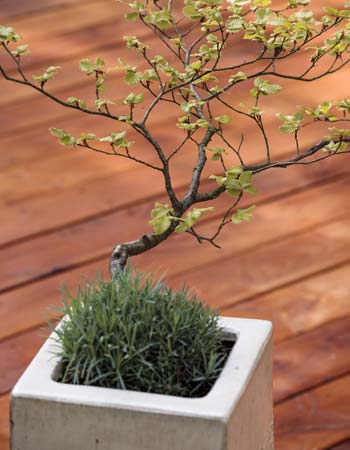
A potted tree (here, a Beech) or how a shrub can become highly decorative.
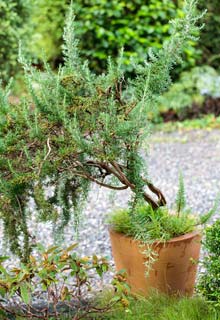
This old Rosemary has gained "character»: It is necessary to accentuate its tortured shape to enhance it.
A silhouette which stands out
A lot of plants, particularly shrubs, see their branches multiply or come down to a small number, depending on the cases. Hydrangeas have a tendency for example to form numerous small stems whereas Maples form a not very ramified trunk. The starting effect modifies and without any human intervention, the scene can become a little sad when to the contrary you have a real opportunity to compose scenery with mature plants. The first task is therefore to take a good look at the plants to assess what needs enhancing, like the branches’ frame or on the contrary a bulk which has become too important because of branches uncontrolled growth.
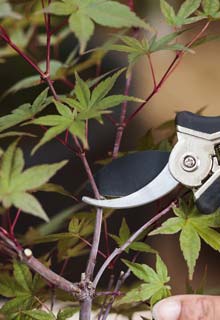
Clear the main branches in cutting all the sickly, frail branches from the base.
Pruning to start with
Once you have taken a good look at your plant, prune whatever is out of shape. The season from October to March is the best time to do this pruning as the silhouette is at its most visible when the leaves have fallen. Clear the framing branches in cutting right back (at 5mm from the trunk) the small stems which cloud the silhouette. On the branches where you prefer to have volume, shorten (or remove in cutting right back) the frail branches which get out of this volume. In all cases, make the most of it to give the plant a good clean: remove all the dead branches and everything that makes the plant look ugly.
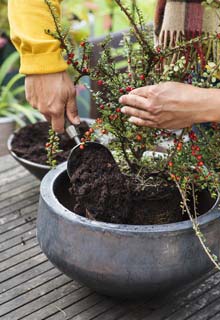
Add some compost wherever the level has subsided.
Restore level
The substrate also has a tendency to subside over time which is normal. Add some more potting compost. The most rapid is to level up on the surface but it is worth adding some compost underneath, particularly for plants which do not like being buried deeply like Hibiscus or evergreen shrubs. In that case, remove the plant from its pot, add some compost at the bottom and put the plant back in it. Obviously, the root ball must not be higher than the pot! Beware of the substrate subsiding at the bottom: it must not lead to roots’ asphyxia (manifested by rotting, a brown tint and unpleasant smell). In that case, the plant will need re-potting.
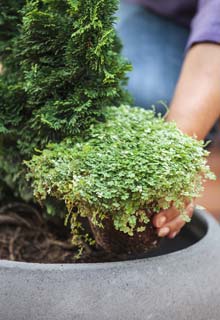
Grow a ground-covering plant at the base of a small, pot-grown, conifer.
Even more beautiful
Once the reshaping and cleaning work has been done, all that’s left to do is the finishing touches. At the base of tall specimens where the soil is bare, plant a ground-covering plant like an Ophiopogon (Mondo grasses) or some Helxine (Friendship plant). These superficial-rooting plants are not too much in competition with deep-rooting plants like shrubs. You probably will have to undo the earth ball of the newcomers to insert them in the pot if a plant is already growing in it. You can also place a layer of big stones if you wish to have a ‘mineral’ effect. Do not hesitate to group the pots together so as to create different sceneries. Some plants can find a place at the back, particularly if their stem is not very graceful.
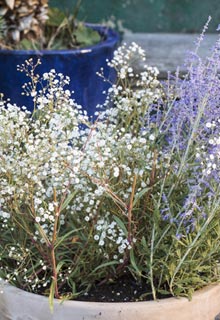
Gypsophila is useful to create a sort of mist around other plants.
A little touch of 'madness'
Another technic to ‘waken’ a plant which lacks of liveliness consists in growing a flowering- climber which will add colour to it without nevertheless, stealing its light. You must choose a plant which is not too vigorous and place its pot close to the plant that needs rejuvenating, guiding the creeping stems through it. Clematis and Jasmines are perfect in that role as they have moderate vigour while looking very attractive. Furthermore, you don’t need to supply them with a special support.
Create links
Do not hesitate repeating a same variety from one pot to another so as the entire setting looks more homogenous. Small, sober plant which grow everywhere without stealing the nutrients of the plants growing close to them are the most suitable. Think about spreading out Heucheras, Mondo grasses (Ophiopogon), Ivies, carnations, violas, etc. Prefer rather small plants as they will find their place and create a natural looking display.
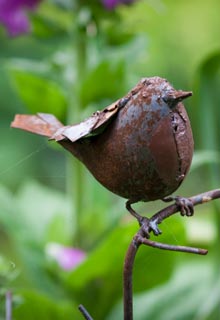
Small decorative objects are always best niched amongst plants.
Add decorations
When a plant has lost its attractiveness, for example because it has finished blossoming and only shows its foliage for the rest of the season, offer it something to make it looking pretty again! The ideal is a decorative object to place in its pot: birds, butterflies and dragonflies are favoured by a lot of gardeners but you can also envisage using non-representative items, even content yourself with painted stakes, etc. The essential is to use the plant which needs enhancing so that the decorative object plays with its foliage bringing in contrast to it. Combine a dark object to light foliage, a heavy-shaped object to a thin, fine foliage, etc.















































































































































































































































